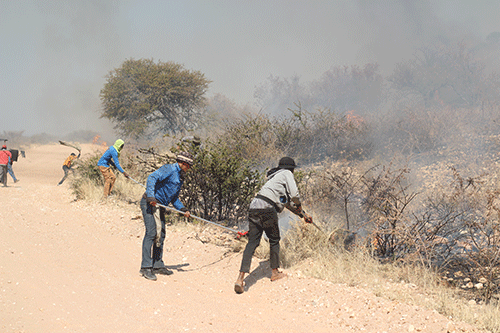Over 580 480 hectares have been burnt as the country continues to witness some devastating fires threatening lives, property, a degradation of the natural environment as well as the destruction of crops, livestock and game across Namibia.
From May to September 2021, 99 veld fires occurred in Omusati covering 11 554 hectares, Khomas: 75 000 ha, Oshikoto: 18 900 ha, Zambezi: 80 420 ha, Kunene: 100 167 ha, Kavango East: 40 000 ha, Kavango West: 45 500 ha, Omaheke: 30 764 ha, Otjozondjupa: 85 891 ha and Hardap covering 20 284 ha.
In Omusati, an unspecified number of goats and sheep burnt to death, while cattle posts were destroyed. In Khomas, many farms burnt, leaving 491 livestock and game killed. One person died, and others were severely injured.
These figures were announced by environment and tourism minister Pohamba Shifeta on Wednesday in the National Assembly when he gave an update on Namibia’s devastating fire season which started in May, as is the case almost every year.
The frequency, intensity and extent of veld fires annually has become a serious concern for both farmers and the environment and tourism ministry, despite government’s continued calls to members of the public and stakeholders to prevent the occurrence and spread of fires.
Since veld fires broke out, most farmers struggled to put out the fires, resulting in huge losses. The most fire-prone regions are Kavango East, Kavango West, Otjozondjupa, Oshikoto, Zambezi, Ohangwena, Kunene, Oshana, Omusati, Khomas, Hardap and Omaheke. Namibia received good rains during the last rainy season, resulting in a high volume of biomass, making the country even more prone to veld fires.
Shifeta said fire remains a major threat to the conservation of forest resources whilst ultimately affecting grazing and other social and economic benefits people derive from forests. “It is worrisome to observe that the country continues to report fire incidences destroying properties and the environment, and putting people’s lives in danger. Severe fires also disrupt the ecosystem and affect natural processes, which may be crucial in sustaining our livelihoods,” he noted.
Shifeta reiterated that the prevention and suppression of veld fires is not the solitary responsibility of the government. Members of the public, farmers or landowners and all stakeholders are called upon to put in place the necessary fire prevention measures such as fire cut lines or fire breaks of 15m width in and around their properties, as well as to have in place basic firefighting tools to assist in case a fire occurs. Equally, other land users such as charcoal burners and picnickers are urged to strictly adhere to fire prevention measures.
Although Shifeta recognises the importance of fire in people’s livelihoods, he said they have noted with great concern that most of the time, destructive fires are caused by irresponsible behaviour or attitudes.
The ministry has thus developed a fire management strategy aimed at capacitating stakeholders and the public through education, and training local communities in basic fire prevention and firefighting skills.
As part of the strategy, the ministry has started with the internationally-accepted practice of the prescribed early burning mechanism, which is the pre-planned ignition of fire for specific purposes such as fuel reduction, habitant modification, the improvement of natural resources and removal of encroacher bush.
Additionally, the ministry facilitates the preparation of extensive networks of firebreaks annually, and to this effect, “we are clearing firebreaks in most of the fire-prone regions,” the minister said.
In 2020, they facilitated the construction or maintenance of 953 kilometres of firebreaks. This year, the ministry planned to facilitate the maintenance of 2 117 kilometres of firebreaks. Additionally, the Oshana region planned to clear 300km this year, whereby 90kms have been cleared already by using the agriculture ministry’s tractors.
The Oshikoto region planned to clear 125km, the Omusati region 492km, the Ohangwena region planned to clear 150km, with 125km cleared by using the environment ministry’s grader, Kavango East planned 150km, Kavango West planned to clear 300km and the Zambezi region planned to clear 200 km. Otjozondjupa planned to clear 250 km, and Kunene planned to clear 150 km.
–anakale@nepc.com.na


